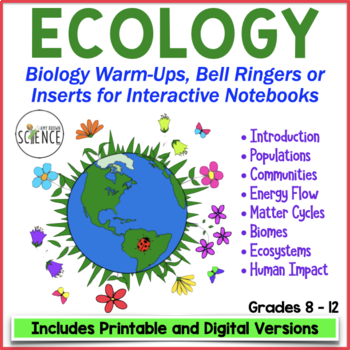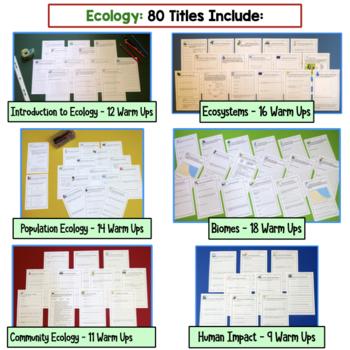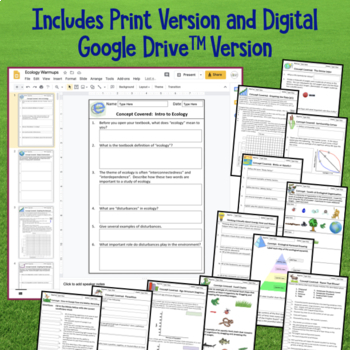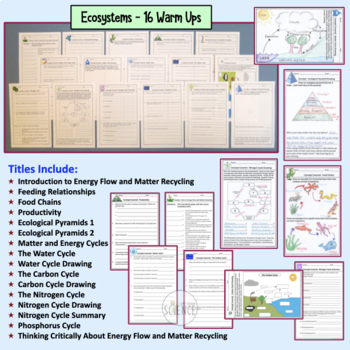ECOLOGY Bell Ringers Warm Ups Ecosystems, Populations, Ecological Relationships
- Zip
- Google Apps™
- Microsoft OneDrive

What educators are saying
Also included in
- This resource is a set of 300+ Warm-Ups, Bell-Ringers, or Exit Slips for 6 different units of study. This bundle covers: Introduction to science, cell structure and function, photosynthesis, respiration, cell division, ecology, genetics, DNA, RNA, protein synthesis, evolution, population genetics, tPrice $55.00Original Price $74.20Save $19.20
- This resource consists of ONE FULL YEAR of Biology No Prep Warm Ups, Bell Ringers, and Inserts for Interactive Notebooks. This is a huge bundle of 35 sets of warm ups and bell ringers covering all chapters in a typical biology textbook:Introduction to ScienceCell Structure and FunctionEcologyGenetiPrice $182.00Original Price $254.63Save $72.63
Description
This resource is a set of 80 Warm-Ups, Bell-Ringers, Exit Slips, and/or Interactive Notebook Pages for your Ecology unit. These activities are perfect for the first few minutes of your class. Both printable and digital versions are included. The 80 student pages cover all ecology topics: Introduction to Ecology, Population Ecology, Community Ecology, Ecosystems, Energy Flow and the Recycling of Matter, the Biogeochemical Cycles, Biomes, and the Human Impact on the Environment.
Both printable and digital versions are included. The student handouts can be printed or used in the paperless digital format in your Google Drive, Google Classroom, Microsoft OneDrive, or similar. This resource is perfect for traditional classroom settings, 1:1 schools, or for distance learning.
Included in this resource:
- 80 Printable and Editable warm-up or bell-ringer activities
- Digital paperless versions (not editable) for use in Google Drive, Google Classroom, and/or Microsoft OneDrive
- Complete answer keys
- Teacher Guide for Warm Ups
- Teacher Guide for Google Apps
- Editable Template pages for starting a warm-up interactive notebook (title page, table of contents)
- Editable Template for creating your own warm-ups.
Absolutely NO PREP required!
How can these be used?
- Warm Ups or Bell Ringers
- Exit Slips
- Additions to interactive notebooks
- Homework assignments
- Tutoring and Review
- Completed notebook is perfect for semester exam review.
=========================================================================================
Try before you buy. Click here to download a free sample of my warm ups, bell ringers, and interactive notebook pages. The sample pack includes pages from many of my warm up units.
=========================================================================================
Classroom management is a very large part of what we do every day as science teachers, and the first few minutes of a class period can be somewhat chaotic. You can turn this chaotic time at the beginning of your class into an organized time of meaningful learning.
Please Note: These warm-ups are designed to take 5-7 minutes to complete. They are used for review and reinforcement of key concepts, but are not intended to be used as first-time instruction. Students will need prior instruction and/or textbook to complete these warm ups. This resource contains pages that can be used as warm ups, bell ringers, inserts for your interactive notebooks, homework assignments, or classwork.
This resource does not include teaching materials such as textbook readings, informational text readings, or a teaching PowerPoint.
The pages are printed landscape style. The pages look best if printed in color, but also look great if printed in black/white. Each activity is one-half page in size. Two identical warm-ups are printed per page in order to conserve paper. These half-page activities can be collected and quickly graded, or you might want to have your students keep a daily warm-up notebook. These warm-ups will make excellent additions to your interactive notebooks.
Ecology topics are organized into the following categories: (1) Introduction to Ecology, (2) Population Ecology, (3) Community Ecology, (4) Energy Flow and the Recycling of Matter, (5) Biomes, and (6) Humans in the Environment. There are 80 total student pages.
Introduction to Ecology (12 pages):
- Introduction to Ecology
- Today’s Environment
- Graph the Data 1
- Graph the Data 2
- What Affects Climate?
- The Ozone Layer
- The Greenhouse Effect
- Levels of Ecological Organization I
- Levels of Ecological Organization II
- Biotic and Abiotic Factors
- Habitat and Niche
- Thinking Critically About Ecology
Population Ecology Titles (14 pages):
- What is a population?
- Dispersion Patterns
- Survivorship Curves (Patterns of Mortality)
- Life History
- Introduction to Population Growth
- Exponential Growth
- Carrying Capacity
- Logistic Growth
- Limits to Growth
- Density Dependent Factors
- Density Independent Factors
- Human Population Growth
- Age Structure Diagrams
- Thinking Critically About Populations
Community Ecology Titles (11 pages):
- Community Interactions
- Competition
- Predation
- Parasitism
- Symbiosis
- Name That Relationship!
- Properties of Communities
- Disturbances
- Succession Part 1
- Succession Part 2
- Thinking Critically About Communities
Energy Flow and the Recycling of Matter Titles (16 pages):
- Introduction to Energy Flow and Matter Recycling
- Feeding Relationships
- Food Chains
- Productivity
- Ecological Pyramids 1
- Ecological Pyramids 2
- Matter and Energy Cycles
- The Water Cycle
- Water Cycle Drawing
- The Carbon Cycle
- Carbon Cycle Drawing
- The Nitrogen Cycle
- Nitrogen Cycle Drawing
- Nitrogen Cycle Summary
- Phosphorus Cycle
- Thinking Critically About Energy Flow and Matter Recycling
Biomes Titles (18 pages):
- Introduction to Biomes
- Tropical Rain Forest
- Temperate Deciduous Forest
- Savanna
- Desert
- Temperate Grassland
- Chaparral (Woodland, Shrubland)
- Taiga (Boreal Forest)
- Tundra
- Name That Biome!
- Marine Ecosystems
- Ocean Zones 1
- Ocean Zones 2
- Ocean Zones 3
- Hydrothermal Vents
- Estuaries
- Freshwater Ecosystems
- Thinking Critically About Biomes
Humans and the Environment Titles (9 pages):
- Humans in the Biosphere
- Resources
- Forest Resources
- Air Resources
- Fisheries and Water Resources
- The Ozone Layer
- Carbon Dioxide Levels
- The Biodiversity Crisis
- Thinking Critically About Humans and the Environment
Click these links to view other available units:
Introduction to Science Warm Ups and Bell Ringers
Cell Structure, Function, and Physiology Warm Ups and Bell Ringers
Genetics Warm Ups and Bell Ringers
DNA, RNA, and Protein Synthesis Warm Ups and Bell ringers
Evolution and Classification: Warm Ups, Bell Ringers and Interactive Notebooks
Interactive Notebooks and Warm Ups Big Bundled Set Part 1
Viruses and Bacteria Warm Ups and Interactive Notebook Pages
Fungi Warm Ups and Interactive Notebook Pages
Protista Kingdom Interactive Notebook Pages
The Human Body: An Introduction Warm Ups and Interactive Notebook Pages
The Human Body: Skeletal, Muscular and Integumentary Systems
The Human Body: Circulatory System Interactive Notebook Pages and Warm Ups
The Human Body: Respiratory System Warm Ups and Interactive Notebook Pages
The Human Body: Digestive System Warm Ups and Interactive Notebook Pages
The Human Body: Excretory System Warm Ups and Interactive Notebook Pages
The Human Body: Immune System Warm Ups and Interactive Notebook Pages
The Human Body: Nervous System Warm Ups and Interactive Notebook Pages
The Human Body: Endocrine System Warm Ups and Interactive Notebook Pages
The Human Body: Reproductive System Warm Ups and Interactive Notebook Pages
The Human Body and Drugs Warm Ups and Interactive Notebook Pages
The Human Body BIG BUNDLED set of Interactive Notebook Pages and Warm Ups
Plant Evolution and Classification Warm Ups and Interactive Notebook Pages
Plant Structure and Function Warm Ups and Interactive Notebook Pages
Plant Reproduction and Response Warm Ups and Interactive Notebook Pages
No Prep Interactive Notebook Pages and Warm Ups Big Bundle 2
Introduction to the Animal Kingdom Warm Ups and Interactive Notebook Pages
Porifera, Cnidaria and Ctenophora Warm Ups and Interactive Notebook Pages
Platyhelminthes and Nematoda Warm Ups and/or Interactive Notebook Pages
Mollusca and Annelida Warm Ups and/or Interactive Notebook Pages
Phylum Arthropoda Warm Ups and Interactive Notebook Pages
Phylum Echinodermata and the Invertebrate Chordates
The Fish: Agnatha, Chondrichthyes and Osteichthyes
The Amphibians: Warm Ups and Interactive Notebook Pages
The Reptiles Warm Ups and Interactive Notebook Pages
Class Aves - The Birds Warm Ups and Interactive Notebook Pages
The Mammals ~ Warm Ups, Bell Ringers, Interactive Notebook Pages
Animal Behavior Interactive Notebook Pages and Warm Ups
No Prep Interactive Notebook Pages and Warm Ups Big Bundle 3
In this time saving classroom management strategy, all you have to do is print the pages, cut them in half and put your students to work.
Related Products Include:
Introduction to Ecology Complete Teaching Unit Plan Bundle of Products
Introduction to Ecology PowerPoint with Notes for Teacher and Student
Ecology Chat 1: Introduction to Ecology
Ecology Chat 2: Population Ecology
Population Ecology PowerPoint with Notes for Teacher and Student
Community Ecology PowerPoint with Notes for Teacher and Student
Ecosystems and the Biosphere Part 2: Biomes of the World PowerPoint and Notes
Human Impact on the Environment PowerPoint and Notes
FREE Set of Six Ecology Crossword Puzzles
Population Ecology Lab: The Wild Bean Population
Ecology Activity: Modeling Population Growth
Lichens: Informational Text, Critical Reading and Lab Activity
Predator Prey Informational Text and Graphing Activity
For updates about sales and new products, please follow my store:
I would love to have you follow me at these locations as well:
My Blog: Amy Brown Science.com
Instagram: @AmyBrownScience







